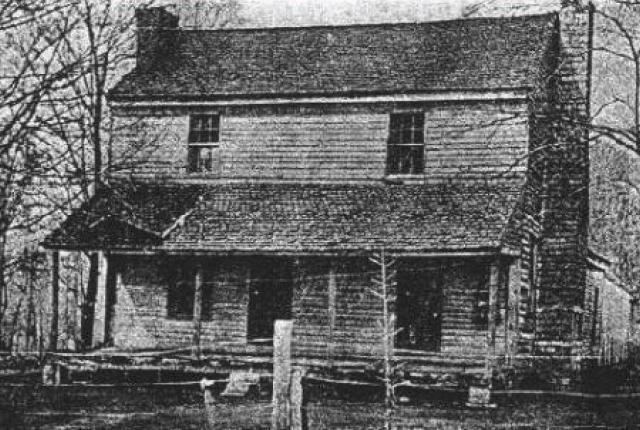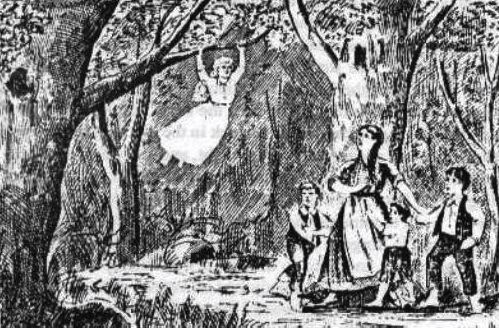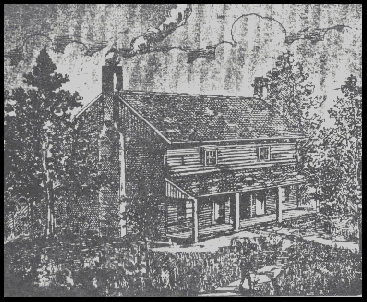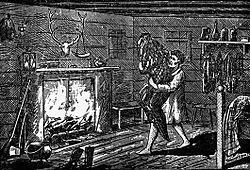Country United States | Sub grouping Spirit Other name(s) Kate | |
 | ||
Similar creatures Poltergeist, Jinn, Demon, Goblin | ||
True stories the bell witch haunting
The Bell Witch or Bell Witch Haunting is a poltergeist legend from Southern folklore, centered on the 19th-century Bell family of Adams, Tennessee. John Bell Sr., who made his living as a farmer, resided with his family along the Red River in northwest Robertson County in an area currently within the town of Adams. According to legend, from 1817-1821, his family and the local area came under attack by an invisible entity subsequently described as a witch. The entity was able to speak, affect the physical environment and change forms. Some accounts record the spirit with the capability to be in more than one place at a time, cross distances with rapid speed and the power of prophecy.
Contents
- True stories the bell witch haunting
- Synopsis
- Biography
- An Authenticated History of the Famous Bell Witch
- Events in the 20th Century
- Skeptical Evaluation
- Film
- Television
- Music and Theater
- References

In 1894, newspaper editor, Martin V. Ingram, published his Authenticated History of the Bell Witch. The book is widely regarded as the first full length record of the legend and a primary source for subsequent treatments. The individuals recorded in the work were known historical personalities. In modern times, some skeptics have regarded Ingram's efforts as a work of historical fiction or even fraud, rather than a nascent folklore study or accurate reflection of belief in the region during the 19th century.

While not a fundamental element of the original recorded legend, the Bell Witch Cave in the 20th century became a source of continuing interest, belief, and generation of lore. Contemporary artistic interpretations such as in film and music have expanded the reach of the legend well beyond the regional confines of the Southern United States.

Synopsis

In his book An Authenticated History of the Bell Witch, author Martin Van Buren Ingram published that the poltergeist's name was Kate, after the entity claimed at one point to be "Old Kate Batts’ witch," and continued to respond favorably to the name. The physical activity centered on the Bells' youngest daughter, Betsy, and her father, and 'Kate' expressed particular displeasure when Betsy became engaged to a local named Joshua Gardner.

The haunting begins in late summer of 1817 with John Bell witnessing the apparition of a dog with the head of a rabbit. Bell fires at the animal but it disappears. Activity moved into the home with sounds of scratching, knocking and smacking lips with sheets being pulled from beds. The phenomenon grew in intensity as the entity pulled hair, slapped, pinched and stuck pins in the family with particular emphasis on Betsy.
The Bells turned to a family friend James Johnston for help. After retiring for the evening at the Bell home, Johnston was awakened that night by the same phenomenon. That morning he told John Bell it was a "spirit, just like in the Bible." Soon word of the haunting spread with some traveling great distances to see the witch. The apparition began to speak out loud and have full conversations and even at one point repeating word for word two sermons given 13 miles apart at the same time.
John Johnston, a son of James, devised a test for the witch, something no one outside his family would know, asking the entity what his Dutch step-grandmother in North Carolina would say to the slaves if she thought they did something wrong. The witch replied with his grandmother's accent, "Hut tut, what has happened now?" On another occasion, an Englishman stopped to visit and offered to investigate. On remarking on his family overseas, the witch suddenly began to mimic his English parents. Again at early morning, the witch woke him to voices of his parents worried as they had heard his voice as well. The Englishman quickly left that morning and later wrote to the Bell family the entity had visited his family in England and apologized for his skepticism.
At times, the spirit displayed a form of kindness, especially towards Lucy, John Bell's wife, "the most perfect woman to walk to earth." The witch would give Lucy fresh fruit and sing hymns to her, and showed John Bell Jr. a measure of respect.
Referring to John Bell Sr. as "Old Jack," the witch claimed she intended to kill him and signaled this intention through curses, threats and afflictions. The story climaxes with the Bell patriarch being poisoned by the witch. Afterward the entity interrupted the mourners by singing drinking songs. In 1821, soon after Betsy called off her engagement, the entity told the family it was going to leave, but return in seven years in 1828. The witch returned on time to Lucy and her son's Richard and Joel with similar activities as before, but they chose not to encourage it, and the witch appeared to leave again.
Several accounts say that during his military career, Andrew Jackson was intrigued with the story and his men were frightened away after traveling to investigate. In an independent oral tradition recorded in the vicinity of Panola County, Mississippi, the witch was the ghost of an unpleasant overseer John Bell murdered in North Carolina. In this tradition, the spirit falls in love with the central character 'Mary' leading to her death, reminiscent of vampire lore. The supernatural powers attributed to the Tennessee spirit have also been compared to that of jinn in mythology.
In the manuscript attributed to Richard Williams Bell, he writes of the spirit:
Whether it was witchery, such as afflicted people in past centuries and the darker ages, whether some gifted fiend of hellish nature, practicing sorcery for selfish enjoyment, or some more modern science akin to that of mesmerism, or some hobgoblin native to the wilds of the country, or a disembodied soul shut out from heaven, or an evil spirit like those Paul drove out of the man into the swine, setting them mad; or a demon let loose from hell, I am unable to decide; nor has any one yet divined its nature or cause for appearing, and I trust this description of the monster in all forms and shapes, and of many tongues, will lead experts who may come with a wiser generation, to a correct conclusion and satisfactory explanation.
Biography
Born near Guthrie, Kentucky, June 20, 1832, Martin Van Buren Ingram took over responsibility of the family farm at the age of 17. A member of Hawkins' Nashville Battalion during the Civil War, he was discharged for disability after the Battle of Shiloh. Ingram began his editing and publishing career in April 1866 with the Robertson Register with no previous experience. October 1868, Ingram moved the paper to Clarksville and began issuing the Clarksville Tobacco Leaf in February 1869. Ingram continued an association with the Leaf until about 1881. The consequences of poor health, family tragedy and fire limited his continuing interest in the newspaper industry.
On the occasion of Ingram's death in October 1909, editor of the Clarksville Leaf Chronicle, W. W. Barksdale, wrote of his friend and colleague:
We doubt exceedingly if there ever lived a man who performed as much self-sacrificing labor to further the interests of the community in which he lived. He became a citizen of Clarksville forty years ago and from that time practically until the day of his death his greatest concern was the advancement and welfare of his adopted town and county.... A man of true mold, he despised all deceit, trickery, and littleness, and with a courage which nothing could daunt, he laid on the journalistic lash unsparingly whenever he thought the occasion required. Naturally, his was not a pathway strewn with roses – his was an aggressive nature, a fact which often brought him into serious collision with those with whom he took issue. Time, however, usually justified him in the positions which he assumed.
An Authenticated History of the Famous Bell Witch
Ingram was reported, February 19, 1890, to have retired as editor from the Clarksville Chronicle. Ingram subsequently traveled to Chicago in October 1893, while editor of the Progress-Democrat, to attempt to publish his An Authenticated History of the Famous Bell Witch. The Wonder of the 19th Century, and Unexplained Phenomenon of the Christian Era. The Mysterious Talking Goblin that Terrorized the West End of Robertson County, Tennessee, Tormenting John Bell to His Death. The Story of Betsy Bell, Her Lover and the Haunting Sphinx. In late March 1894, it was announced a publisher, W. P. Titus, in Clarksville would print the work and it was released a few months later. In the introduction to the book, Ingram published a letter dated July 1, 1891 from former TN State Representative James Allen Bell of Adairville, Kentucky.
J. A. Bell, a son of Richard Williams Bell and a grandson of John Bell, Sr., explained that his father had met with his brother John Bell Jr. before his death and they agreed no material he had collected should be released until the last immediate family member of John Bell Sr. had died. The last immediate member of the family and youngest child of John Bell Sr., Joel Egbert Bell died in 1890 at the age of 77.
Now, nearly seventy-five years having elapsed, the old members of the family who suffered the torments having all passed away, and the witch story still continues to be discussed as widely as the family name is known, under misconception of the facts, I have concluded that in justice to the memory of an honored ancestry, and to the public also whose minds have been abused in regard to the matter, it would be well to give the whole story to the World.
J. A. Bell expressed the belief that his father's manuscript was written when he was 35 years old in 1846. He claimed his father gave him the manuscript and family notes shortly before his death in 1857. Richard Williams Bell was roughly 6 to 10 years of age during the initial manifestations of the Bell Witch phenomenon and 17 at the occurrence of the spirit's return in 1828. The reported contributions of Richard Williams Bell, approximately 90 pages in length, are recorded in Chapter 8 of Ingram's work, entitled Our Family Trouble.
According to Brian Dunning no one has ever seen this diary, and there is no evidence that it ever existed: "Conveniently, every person with firsthand knowledge of the Bell Witch hauntings was already dead when Ingram started his book; in fact, every person with secondhand knowledge was even dead." Dunning also concluded that Ingram was guilty of falsifying another statement, that the Saturday Evening Post had published a story in 1849 accusing the Bells' daughter Elizabeth of creating the witch, an article which was not found at the time. Joe Nickell argues the chapter includes the use of Masonic themes and anachronism which impacts credibility.
The account of General Andrew Jackson's visit is confined to Chapter 11 of Ingram's work. The chapter is a letter from Col. Thomas L. Yancey, an attorney in Clarksville, dated January 1894. Yancey relates that his grandfather, Whitmel Fort, was a witness to phenomena at the Bell homestead and had related the story of Jackson's visit which was undated in the letter.
Paranormal investigator Benjamin Radford, as well as Brian Dunning, conclude that there is no evidence that Andrew Jackson visited the Bell family home. During the years in question, Jackson's movements were well documented, and nowhere in history or his writings is there evidence of his knowledge of the Bell family. According to Dunning, "The 1824 Presidential election was notoriously malicious, and it seems hard to believe that his opponent would have overlooked the opportunity to drag him through the mud for having lost a fight to a witch."
Keith Cartwright of the University of North Florida compares Ingram's work with Uncle Remus folklore as recorded by Joel Chandler Harris and also as an expression of the psychological shame of slavery and Native American removal. The slaves in the account are regarded as experts on the witch, with Uncle Zeke identifying the witch as, "dat Injun spirit...the Injuns was here fust, and we white fokes driv em out, all but dem whar wur dead and cudent go, an da's here yit, in der spirit." The figure of "progress" Gen. Andrew Jackson was brought nearly to heel and the master, John Bell, was dead. The role of the trickster not played by the Br'er Rabbit but the witch-rabbit, the spirit's common animal form. The displaced, blacks, widows and girls, act as witness to a force polite society cannot comprehend. The witch, "appears as a catch-all for every remainder of resistant agency."
Events in the 20th Century
A prophecy was reported in 1903 that the witch could return on the centennial of the Bell family arrival in Tennessee. By September, a local paper was incredulous as she was not reported to have returned in August.
Charles Bailey Bell, a grandson of John Bell Jr., and neurologist in Nashville, published a book entitled The Bell Witch: A Mysterious Spirit in 1934. In the work, he recounted stories told to him by his great aunt Betsy later in her life. This included another account of Andrew Jackson's visit and of a boy trapped in the Bell Witch Cave and pulled out of the cave feet first by the witch. Bell also detailed a purported series of prophecies given to his ancestors in 1828 by the spirit, including the claim the witch was set to return in 1935, 107 years after her last visit to the Bell family.
In 1937, there were reports of quirky events. Louis Garrison, owner of the farm that included the Bell Witch Cave, heard unexplained noises coming from inside. Bell descendants described the sound of something rubbing against a house, a paper like object that flew out the door and reentered through a side door, and faint music heard from a piano. A group from the local Epworth League were reported to have attended a wiener roast in a rock quarry near the Bell Witch Cave on July 29, 1937. The group were joking about the legend when they saw a figure of a woman sitting on top of the cliff over the cave causing many to flee. A minister in the group later claimed to have investigated and discovered it was moon light on a rock. The second report concluded with a weather report that the moon was barely noticeable that night.
In November 1965, an article was published involving an antique oak rocking chair said to have been previously owned by attorney Charlie Willett, a Bell descendant. The rocking chair was recently sold in an estate sale to Mrs. J. C. Adams, owner of an antique store on U.S. 41. A customer sat down in the chair, after learning it was not for sale, and while rocking in the chair asked Mrs. Adams if she believed in the supernatural. Two weeks later, the customer's daughter visited the home of Mrs. Adams and said after her mother had left and visited the Bell cemetery a voice told her to "stand up and look around, you will find something of much value." After some car trouble, the woman walked out into a field and found a black iron kettle turned over. She turned the kettle over and found a pearl buckle in the grass. The woman's daughter reported a jeweler estimated the buckle to be 160 to 200 years old.
Bonnie Haneline, in 1977, recounted a time during her childhood in 1944 when she was exploring the cave. She left English class, playing 'hooky,' and borrowed a lantern from Mrs. Garrison, the cave owner. She reported to have explored the cave with her friends for several years. While she was inside, her lantern blew out despite no breeze inside the cave. She managed to relight the lantern and it blew out again. Terrified, she crawled along the water path of the cave in the dark until she reached the entrance where she saw an opened can of pork and beans and marshmallows. Later that evening, she learned law enforcement discovered two escaped fugitives in the back of the cave. She credited the witch with helping her avoid them.
A visit in 1977 was reported of a group five soldiers from nearby Fort Campbell to the Bell Witch Cave. One of the soldiers was sitting on a rock and expressed skepticism of the legend when something invisible grabbed him around the chest.
In 1986, staff writer David Jarrard for the The Tennessean and photographer Bill Wilson, the latter also a member of the National Speleological Society, were given permission to sleep in the cave over night. While in the first cave room they heard a noise from deeper in the cave Jarrard estimated at 30 yards. Subsequently, an "unwavering groan" repeated again with greater volume and accompanied by several loud thumps. When it began a third time, the men retreated to the gate entrance. They explored the wiring to the lights looking for a reason for the noises. They went back to the first cave room but heard a rumble near the entrance. Walking back to the entrance they discovered the rumble was noise from a jet. As they reached the gate, a loud, high pitched scream emanated from inside the cave. The journalists left and did not spend the night.
In 1987, H. C. Sanders, owner of a nearby gas station, reported 20 years earlier he ran out of gas at night near the Red River across from the Bell Witch Cave. He began to walk towards town when a rabbit came out of the woods and began to follow him. Sanders walked faster, but the rabbit kept pace even as he broke out into a run. After a mile, Sanders sat down on a log to catch his breath. The rabbit hopped up on the other side of the log looked at him and said, "Hell of a race we had there, wasn't it?"
Skeptical Evaluation
According to Radford, the Bell Witch story is an important one for all paranormal researchers: "It shows how easily legend and myth can be mistaken for fact and real events and how easily the lines are blurred" when sources are not checked. Dunning wrote that there was no need to discuss the supposed paranormal activity until there was evidence that the story was true. "Vague stories indicate that there was a witch in the area. All the significant facts of the story have been falsified, and the others come from a source of dubious credibility. Since no reliable documentation of any actual events exists, there is nothing worth looking into."
Dunning concludes, "I chalk up the Bell Witch as nothing more than one of many unsubstantiated folk legends, vastly embellished and popularized by an opportunistic author of historical fiction." Radford reminds readers that "the burden of proof is not on skeptics to disprove anything but rather for the proponents to prove... claims".
Joe Nickell has written that many of those who knew Betsy suspected her of fraud and the Bell Witch story "sounds suspiciously like an example of “the poltergeist-faking syndrome” in which someone, typically a child, causes the mischief."
Film
There have been several movies based, at least in part, on the Bell Witch legend, including The Blair Witch Project in 1999, Bell Witch Haunting in 2004, An American Haunting in 2005, Bell Witch: The Movie in 2007, and The Bell Witch Haunting in 2013.
Television
The American television series Ghost Adventures filmed an episode at the Bell Witch Cave.
An American television series - Cursed: The Bell Witch - based on the latest members of the Bell family trying to end the curse. It premiered October 2015 on the A&E Network.
Music and Theater
Charles Faulkner Bryan, as apart of a Guggenheim Fellowship, composed The Bell Witch, a cantata which premiered in Carnegie Hall in 1947 with Robert Shaw conducting the Juilliard Chorus and Orchestra.
Nashville music group The Shakers released Living In The Shadow Of A Spirit in 1988 on vinyl record EP.
Ann Marie DeAngelo and Conni Ellisor choreographed and composed a ballet entitled The Bell Witch for the Nashville Ballet.
Nashville Children's Theatre premiered Our Family Trouble: The Legend of the Bell Witch in 1976. The play was written by Audrey Campbell.
A play by Ric White, The Bell Witch Story. First performed in 1998 by the Sumner County Players. And performed again in 2008 by the Tennessee Theater Company.
A play by David Alford, Spirit: The Authentic Story of the Bell Witch of Tennessee, performed in Adams, TN during the Bell Witch Fall Festival in late October.
The Danish metal band Mercyful Fate released a song titled "The Bell Witch" on their 1993 album In the Shadows.
Seattle-based doom metal band Bell Witch took their name from this legend.
Merle Kilgore recorded a song titled "The Bell Witch" in 1964.
Madeline recorded a song titled "The Legend of the Bell Witch" in 2014.
